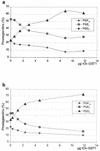A dominant role for extracellular glutathione S-transferase from Onchocerca volvulus is the production of prostaglandin D2
- PMID: 12761146
- PMCID: PMC155740
- DOI: 10.1128/IAI.71.6.3603-3606.2003
A dominant role for extracellular glutathione S-transferase from Onchocerca volvulus is the production of prostaglandin D2
Abstract
The extracellular glutathione S-transferase from the filarial parasite Onchocerca volvulus (Ov-GST1) is a glutathione-dependent prostaglandin D synthase. Ov-GST1, located in the outer hypodermal lamellae and in parts of the cuticle, produces prostaglandin D(2) directly at the parasite-host interface. Ov-GST1 therefore has the potential to participate in the modulation of the host immune response by contributing to the production of prostanoids; this supports the predominant hypothesis that parasite-derived eicosanoids influence host inflammatory and immune cells.
Figures


Similar articles
-
Structure of the extracellular glutathione S-transferase OvGST1 from the human pathogenic parasite Onchocerca volvulus.J Mol Biol. 2008 Mar 21;377(2):501-11. doi: 10.1016/j.jmb.2008.01.029. Epub 2008 Jan 16. J Mol Biol. 2008. PMID: 18258257
-
A novel type of glutathione S-transferase in Onchocerca volvulus.Infect Immun. 1994 Nov;62(11):4762-7. doi: 10.1128/iai.62.11.4762-4767.1994. Infect Immun. 1994. PMID: 7927752 Free PMC article.
-
Pivotal roles of the parasite PGD2 synthase and of the host D prostanoid receptor 1 in schistosome immune evasion.Eur J Immunol. 2003 Oct;33(10):2764-72. doi: 10.1002/eji.200324143. Eur J Immunol. 2003. PMID: 14515260
-
[New aspects on prostaglandin D synthases].Nihon Yakurigaku Zasshi. 1997 Oct;110 Suppl 1:56P-58P. doi: 10.1254/fpj.110.supplement_56. Nihon Yakurigaku Zasshi. 1997. PMID: 9503406 Review. Japanese.
-
Hematopoietic prostaglandin D synthase.Prostaglandins Leukot Essent Fatty Acids. 2003 Aug-Sep;69(2-3):163-7. doi: 10.1016/s0952-3278(03)00077-2. Prostaglandins Leukot Essent Fatty Acids. 2003. PMID: 12895599 Review.
Cited by
-
Stage-specific Proteomes from Onchocerca ochengi, Sister Species of the Human River Blindness Parasite, Uncover Adaptations to a Nodular Lifestyle.Mol Cell Proteomics. 2016 Aug;15(8):2554-75. doi: 10.1074/mcp.M115.055640. Epub 2016 May 25. Mol Cell Proteomics. 2016. PMID: 27226403 Free PMC article.
-
Prostaglandin regulation of type 2 inflammation: From basic biology to therapeutic interventions.Eur J Immunol. 2021 Oct;51(10):2399-2416. doi: 10.1002/eji.202048909. Epub 2021 Sep 7. Eur J Immunol. 2021. PMID: 34396535 Free PMC article. Review.
-
Enzymes of the cyclooxygenase pathways of prostanoid biosynthesis.Chem Rev. 2011 Oct 12;111(10):5821-65. doi: 10.1021/cr2002992. Epub 2011 Sep 27. Chem Rev. 2011. PMID: 21942677 Free PMC article. Review. No abstract available.
-
The tapeworm Diphyllobothrium dendriticum (Cestoda) produces prostaglandin E2, a regulator of host immunity.Dokl Biol Sci. 2011 Nov-Dec;441:367-9. doi: 10.1134/S0012496611060019. Epub 2012 Jan 7. Dokl Biol Sci. 2011. PMID: 22227682 No abstract available.
-
Detoxome Capacity of the Adult Rumen Fluke Calicophoron daubneyi Extends into Its Secreted Extracellular Vesicles.J Proteome Res. 2025 Feb 7;24(2):624-638. doi: 10.1021/acs.jproteome.4c00615. Epub 2025 Jan 19. J Proteome Res. 2025. PMID: 39829022 Free PMC article.
References
-
- Daugschies, A., and A. Joachim. 2000. Eicosanoids in parasites and parasitic infections. Adv. Parasitol. 46:181-240. - PubMed
-
- Günzler, W. A., and L. Flohe. 1987. Glutathione peroxidase, p. 285-289. In R. A. Greenwald (ed.), Handbook of methods for oxygen radical research. CRC Press, Inc., Boca Raton, Fla.
-
- Harris, S. G., J. Padilla, L. Koumas, D. Ray, and R. P. Phillips. 2002. Prostaglandins as modulators of immunity. Trends Immunol. 23:144-150. - PubMed
-
- Hirai, H., K. Tanaka, O. Yoshie, K. Ogawa, K. Kenmotsu, Y. Takamori, M. Ichimasa, K. Sugamura, M. Nakamura, S. Takano, and K. Nagata. 2001. Prostaglandin D2 selectively induces chemotaxis in T helper type 2 cells, eosinophils, and basophils via seven-transmembrane receptor CRTH2. J. Exp. Med. 193:255-261. - PMC - PubMed
Publication types
MeSH terms
Substances
LinkOut - more resources
Full Text Sources
Research Materials

